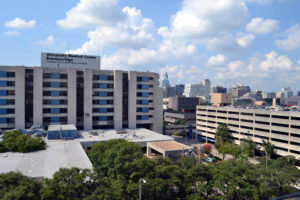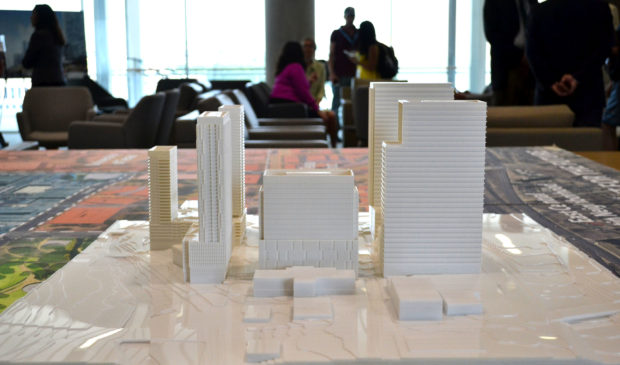Health district enters the real estate game
Friday, September 2, 2016 by
Caleb Pritchard Central Health is now shopping for suitors to help continue the transformation of downtown Austin’s eastern edge.
The health care district on Thursday released a request for qualifications to the development community making official the search for a partner in the redevelopment of the Central Health Brackenridge Campus between Interstate-35 and Waterloo Park.
Central Health CEO and President Patricia Young Brown said she expects as many as 750 firms to throw their hats into the ring.
Responses are due by Oct. 21, after which district officials will begin their evaluation. That winnowing will last until the end of the year. In January, the district will ask the remaining finalists to formally submit proposals for the project.
The redevelopment will aim to fulfill the Central Health Brackenridge Campus Master Plan approved by the agency’s board in January. That document lays out a long-term vision for the 14.3-acre site that includes the original plot of land set aside for a hospital at the city’s incorporation in 1839.
“The redevelopment of this property represents a singular moment in our community’s history, and we look forward to working with the brightest and most thoughtful developers to bring the community’s vision to life,” Brown said.
Brown’s optimism about the number of respondents to the RFQ is no doubt informed by the fundamental rule of real estate regarding the primacy of location. The site is currently home to the University Medical Center Brackenridge hospital, operated by Seton Healthcare Family. Completed in 1974, the complex occupies a superblock on East 15th Street sandwiched between Red River Street to the west and I-35 to the east.

North of the property sits the University of Texas Dell Medical School and the upcoming Dell Seton Medical Center, a teaching hospital to which Seton will relocate once it opens next spring. Overlaying both the medical district and the Brackenridge Campus, stretching south toward Lady Bird Lake, is the so-called Innovation Zone, an area that will be dedicated to innovation.
Three other factors add to the Brackenridge Campus redevelopment project’s appeal: The rescue of hundreds of acres of land along nearby Waller Creek from the 100-year floodplain, thanks to the ongoing construction of an underground tunnel whose mouth opens at what will eventually be a reconstituted Waterloo Park; the Texas Department of Transportation’s planned redesign of I-35 through downtown, which could include taking the road below grade in preparation for a set of deck parks; and the fact that the property is almost wholly unencumbered by height-restrictive Capitol view corridors.
To take advantage of those circumstances, the project’s master plan sets out phasing and design guidelines that potential developers will have to consider. They include a three-phase process, with work beginning in 2017 and ultimately ending in 2035. The plan includes a substantial focus on pedestrian and bicycling infrastructure and also includes a bus plaza on a newly realigned Red River Street.
At the heart of a small grove of six residential, commercial, medical and hotel high-rises depicted in the master plan’s “preliminary hypothesis” of the site is a public market that Brown insisted on Thursday will be oriented to community purposes.
Brown also said that the project could include some affordable housing component but likely only for residents whose income is 60 percent the median family income or above. She said that although the health district’s mission includes providing health care for extremely low-income residents, market forces would likely preclude any developer from incorporating housing for families making only 30 percent of the median family income.
“That’s not going to happen,” said Brown.
Another market force could also affect the amount of parking at the project. The hypothetical example of the master plan includes elevated parking podiums beneath all six towers despite the project’s central location, emphasis on multimodal forms of transportation and the potentially transformative change that could be ushered in by autonomous cars.
Central Health Vice President of Finance and Development Juan Garza told the Austin Monitor on Thursday that the inclusion of parking is usually a requirement from the risk-averse financial community. He noted the possibility that some of the project’s garages could be engineered to allow for a future retrofit should transportation norms change in the coming decades.
The publicly owned land that Brackenridge sits on will not be taxable, but the buildings added by the developer will be. Garza said the air rights would be leased to the developer for an extended period of time – likely 99 years, according to Garza – after which ownership will transfer to Central Health. Garza estimated that once the project is complete, the towers could add as much as $1 billion worth of taxable value to local rolls.
The last paragraph of this story has been corrected. Garza was mistakenly identified as “Ruiz”.
The Austin Monitor’s work is made possible by donations from the community. Though our reporting covers donors from time to time, we are careful to keep business and editorial efforts separate while maintaining transparency. A complete list of donors is available here, and our code of ethics is explained here.
You're a community leader
And we’re honored you look to us for serious, in-depth news. You know a strong community needs local and dedicated watchdog reporting. We’re here for you and that won’t change. Now will you take the powerful next step and support our nonprofit news organization?










